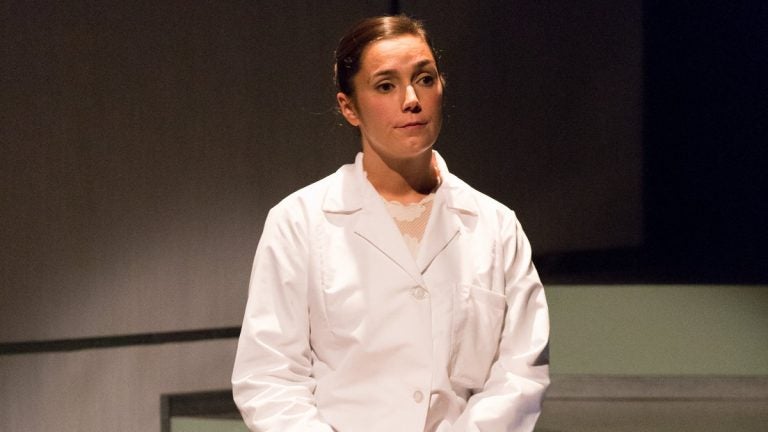Review: The one-dimensional images in ‘Photograph 51’
Listen
Geneviève Perrier in Lantern Theater Company's production of 'Photograph 51.' (Photo courtesy of Mark Garvin)
They can be brilliant and they can be cynical, petty, cutthroat hypocrites. I’m not referring to the usual suspects – I’m talking about the scientists. The scientists? Yes, according to the play “Photograph 51,” now in a Lantern Theater production outstanding for its acting and staging, scientists are … like everyone else.
History backs that notion. Rosalind Franklin was the British scientist who made images, through her demanding work with X-rays, that led to the discovery of the structure of DNA and ultimately to our genetic code. Other British scientists were working on similar projects in the ’50s (as was Linus Pauling in the United States). They may or may not have stolen her findings, or somehow come upon them. Using Franklin’s own images – specifically one called Photograph 51 — they got the jump on her.
They were awarded the Nobel Prize in 1962, but not Rosalind Franklin. She probably would have been. We’ll never know. The prize goes only to living scientists, and she died at age 37, four years before it was awarded.
That’s a compelling story, but you won’t find it all in Anna Ziegler’s “Photograph 51,” which focuses sharply on Rosalind Franklin’s attempts to unlock a scientific secret despite a professional culture driven by unwelcoming good old boys. The play never follows through with the historic details, but only suggests them, and also suggests that her male colleagues — and not the Nobel’s own rules — deprived her of The Prize.
If the playwright’s portrait of the male scientists is otherwise accurate, they began to understand the makeup of molecules but never when those molecules composed a woman. If the portrait of Franklin is accurate, the young scientist did everything she could to encourage the sexism and general nastiness that enveloped her in the laboratory – she out-nastied everyone from the get-go.
“Photograph 51” isn’t a great play – in its construction, it comes across as artificial. Characters talk to us and then to one another, and after that they question the scene we’ve just witnessed. Plus, they are annoyingly one-dimensional. The script offers leaden pronouncements: “Didn’t she feel that something was at her back? A force greater than she was?” asks one scientist of the others whose behavior toward Franklin was suspect. “You mean us?” one of them replies. “No, I mean … faith,” comes the answer, in a play that has never yet welcomed faith of any sort into the room.
But never mind such deliverances. “Photograph 51” has become popular here at Lantern in an extended run and on the West End in London where Nicole Kidman takes the lead role. Even with its flaws, “Photograph 51” remains a story of high-level competition, cheating, less-than-respectable science and outright sexism, with a whiff of anti-Semitism thrown in (Franklin was Jewish).
Kathryn MacMillan, who directs the play for Lantern, takes its collection of six cardboard cutouts – all drawn from real life – and overcomes their lack of nuance by providing an intensity that runs steadily through 100 minutes. Her staging, on several levels of Meghan Jones’ sterile-laboratory set, ties the characters tightly together through different stages of their work and discovery.
If you’re going to play a block of ice – that’s the way “Photograph 51” depicts Franklin – you may as well spread the nip around. That’s what Geneviève Perrier does with great skill in her portrayal of Franklin; the room gets colder and colder as she becomes more focused on her work and more openly disdainful of her colleagues. You’ve heard of a chilling performance? Perrier’s is literal. Because Franklin is a wholly unlikable character pitted against a group of jerks, the frostiness works in a strange way. At times, we’re compelled to applaud it.
As for the colleagues, all are played with aplomb: Joseph McGranaghan is Franklin’s clueless immediate boss; Harry Watermeier is the doctoral student trying to work with her; Trevor William Fayle portrays the sleazy scientist who may have usurped her work (and attempted in later years to mask his racism with scientific theory). Harry Smith plays another scientist who’s a light-weight compared to Franklin, and Chris Anthony portrays the only character we might like to spend any time with, a freshly minted doctor of science who comes to work with Franklin and also manages to become a friend.
Ziegler writes that her play is “a memory of the 1950s,” which I guess gives her license to construct it in a sort of cloud. Lantern’s production works because it brings it down closer to earth, particularly to the way we work together, or don’t, today.
“Photograph 51” is extended through Oct. 18 at Lantern Theater’s space in St. Stephen’s Theater, behind St. Stephen’s Episcopal Church, on Tenth Street between Market and Chestnut Streets. lanterntheater.org or 215-829-0395.
WHYY is your source for fact-based, in-depth journalism and information. As a nonprofit organization, we rely on financial support from readers like you. Please give today.




